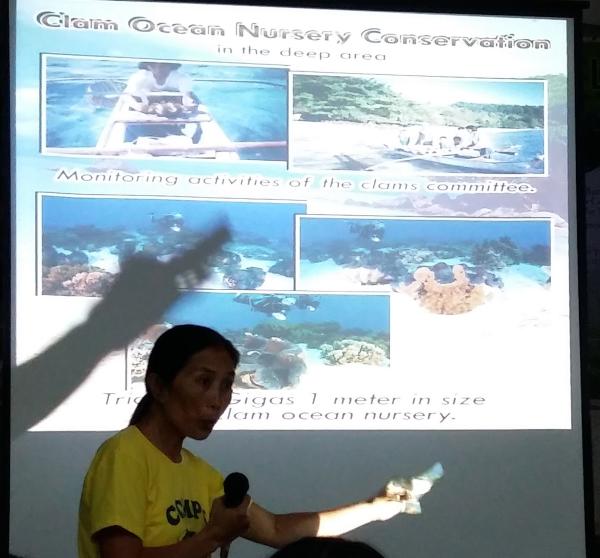
Anita Cordero shows how they grow giant clams in Camiguin to Lilo-an fisherfolks, town and barangay officials. (CDN PHOTO/ MARIAN Z. CODILLA
Eighty-seven families were recognized for their efforts to restore the giant clam population in their fishing village of Cantaan, Guinsiliban town in Camiguin province.
From 30 in 1997, there are now over 4,000 clams in the area. Fish catch also improved.
The Cantaan Clam Conservation Site is home to six of the seven giant clam species in the world including the Tridacna gigas.
The village has become a tourist spot, allowing the residents to earn on the side.
“It takes a lot of patience to achieve this. Today many tourists visit our site and we have recovered the P250,000 financial assistance that DENR gave us,” said Anita Cordero, president of the Cantaan Centennial Multi-purpose Cooperative.
Children serve as tourist guides and can recite the scientific name of each species. The site earns P100,000 from conservation and viewing fees collected from tourists. The cooperative also earns from diving equipment rentals.
Cordero shared the cooperative’s experience yesterday with barangay and town officials, fisherfolk and sanctuary wardens in Lilo-an town, Cebu as part of a series of forums organized by the Ramon Aboitiz Foundation, Inc. for its Triennial Awards.
The cooperative, founded in 1997, is a finalists for the Eduardo Aboitiz Award for Outstanding Institution. The winner will be known tomorrow.
Cordero said Lilo-an town, which has three marine protected areas, could follow their example.
“Our clams are growing in population and we want these replicated in other parts of the country,” she said.
She said the project would create jobs and help uplift families from poverty.
“It’s time we don’t rely entirely on the government,” she added.
Cordero said they were inspired to start after barangay captain Rolando Cordero received the Gawad Saka Outstanding Capture Fisherman award for initiating conservation measures.
They started with 30 clams from Pangasinan in 1997.
In the early years of the cooperative, housewives and children brushed the juvenile giant clams, taking note of their growth and making sure they don’t pile up.
The cooperative helped set up livelihood projects such as sari-sari stores.
In 2002, part of the conservation site was opened to tourists, earning income for the cooperative.
Cordero said they contributed to the town’s road concreting projects and gave additional honorarium for day care teachers in their barangay.
“We had a lot of challenges before. Now we are reaping the benefits. The benefit is indirect. We don’t sell the giant clams because this is prohibited. But tourists have increased over the years and our marine resources are richer,” Cordero said.
Disclaimer: The comments uploaded on this site do not necessarily represent or reflect the views of management and owner of Cebudailynews. We reserve the right to exclude comments that we deem to be inconsistent with our editorial standards.
